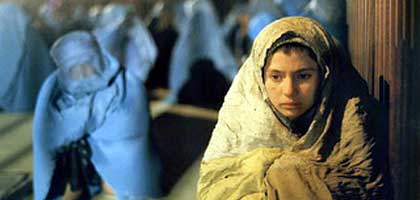
Afghan Aftermath

Osama, Siddiq Barmak's study of one girl's life under the Taliban, is a big critical success, but will it help to build a new Afghan cinema, asks Dave Calhoun.
Two of the films premiered at last year's Cannes film festival were made in Afghanistan during 2002, only months after the end of the war: Osama , by Afghan director Siddiq Barmak, and At Five in the Afternoon , by Iranian Samira Makhmalbaf. The presence of both at Cannes, and their subsequent journey around the world's film festivals (Osama won the Sutherland Trophy at the 2003 London festival), hinted that a new film culture might be emerging from the country's ruins. Indeed Osama was heavily promoted as the first Afghan film made since the rise to power of the Taliban. But how far do these two films represent signs of a permanent change in the fortunes of Afghanistan's cinema?
Afghan film-makers such as Barmak - who headed the national film institute, Afghan Film, until the beginning of Taliban rule in 1996 - have returned to the country to encourage a new generation of film-makers to pick up a camera and foreign film-makers to invest. In this respect Iran has played a crucial role, not least in the person of director and producer Mohsen Makhmalbaf (father of Samira), who has dedicated himself to the regeneration of Afghanistan and its cinema.
But even before the Taliban Afghanistan's film industry was slight: the country had only ever produced 40 or so long and short films, which compares miserably with its neighbours India and Iran. So when the Taliban took control of much of the country in 1996, the film-production infrastructure amounted to little more than a lab used for printing copies of foreign films, a few dilapidated editing tables and one camera in a serious state of disrepair.
The years of Taliban rule only made things worse: all cinemas were shut down or torched and in 2001 a senior official visited Afghan Film and ordered staff to burn their entire stock of 3,000 films. (They managed to save around 1,000 by hiding them in a back room.) Under the Taliban even to watch a film was a subversive act, and when Samira Makhmalbaf was shooting At Five in the Afternoon in Kabul (as documented by her sister Hana in Joy of Madness , 2003) she found few young people willing to work as extras. Many were scared of the camera and most believed that acting would entail dancing, a pursuit still frowned on in conservative quarters.
The situation today is starting to improve. There are now eight cinemas operating in Kabul, mostly showing Indian films. Afghan Film is slowly being re-equipped and some private companies are emerging from the dust of older firms such as Ariana Film and Kabul Film. New initiatives include a production company set up by Bollywood actor Hashmat Rahmini (known to audiences as Hashmat Khan), himself an Afghan.
Barmak, now a senior figure at the revived Afghan Film, won a scholarship to study film at Moscow University in 1981, during the Soviet occupation of his country. On his return to Afghanistan in 1987 he worked on short films and from 1992 headed Afghan Film. His work has mostly focused on Afghanistan's troubled political landscape. "When I finished studying in Russia and returned to Afghanistan I joined one of the Mujahadeen groups fighting the Russians. I joined to set up a centre for documentary and feature films because I wanted to help create a cultural side to their organisation. Fighting and weapons do not make our future."
In 1996 Barmak fled to the north and made documentaries for Northern Alliance leader Ahmed Shah Massoud before going into exile in Pakistan. After the end of Taliban rule he returned and worked on a series of short educational films on such subjects as health and unexploded mines, which were shown in mobile cinemas to audiences around the country. "We took them to some very remote areas," says Barmak. "Most of the population is not educated, not able to read newspapers, so pictures are very useful and powerful."
For Barmak, cinema, education and social regeneration are closely interlinked. In Osama he used the story of a single family to reflect on the experience of Afghans living under the Taliban. A young girl (played by 13-year-old Marina Golbahari, whom Barmak found on the street) lives with her mother and grandmother, both forbidden to work under Taliban rules. With her father and grandfather dead, the girl cuts her hair and pretends to be a boy so she can take a job in a local bakery; she is then pressurised by a Talib to attend a religious school for boys. When her duplicity is discovered she is prosecuted by a religious court and forced to marry an elderly Mullah.
Osama explores various characteristics of Taliban rule - the oppression of women, religious fundamentalism, protest and its suppression - in an accessible, even thrilling, way. Barmak was determined to appeal to as broad a range of Afghans as possible, to make a film that reflected their experiences and could be watched in local cinemas. But Afghan audiences have yet to see Osama , and there's some doubt as to when it might be screened in a country where conservative tendencies remain strong.
Foreign finance was crucial to Osama 's production, with a significant proportion of the initial funds and most of the technical support coming from Iran (alongside Japanese and Irish co-producers). Key to raising this was Mohsen Makhmalbaf, whose concern for the Afghan people has spread far beyond film-making. Soon after shooting Kandahar on the borders of Afghanistan in 2000 Makhmalbaf turned his attention to the plight of uneducated Afghan refugees in Iran and directed the documentary The Afghan Alphabet on the subject. He also founded the Afghan Children Education Movement (ACEM), originally dedicated to addressing the lack of education available to the 1.5 million Afghan refugees banned from attending Iranian schools. In an open letter to Iran's President Khatami in mid 2001 Makhmalbaf offered to use ACEM to attract money from foreign sources to improve Iran's schools if Khatami would allow Afghan refugees into the classrooms. Khatami agreed and Makhmalbaf secured initial financial support from UNESCO and lobbied for donations through television and newspaper appeals.
To date ACEM has set up over 80 projects, from buying books to building new schools, and has supported health and medical initiatives. After the fall of the Taliban the organisation moved into Afghanistan itself, reconstructing the Kabul orphanage and building three new schools in Herat. ACEM has also paid for ten short films by Afghan film-makers, funded 20 Afghan film-makers to attend courses and directed money from the Iranian government ($25,000) and the Makhmalbaf Film House ($21,000) towards the production of Osama . In late 2002 Barmak took over from Makhmalbaf as the head of ACEM.
Both Barmak and Makhmalbaf recognise the limitations of cinema as an instrument of regeneration and education. But Makhmalbaf does believe that cinema can help the Afghan people to discover more about themselves and the rest of the world. "The cinema audience is mainly children and youths rather than the conservative elderly. Cinema acts like a mirror for society to look at its spirit and correct its faults, and Afghanistan has lived so much without the mirror of cinema we can almost say this nation does not recognise its own image."
Meanwhile Barmak's aim is to develop a specifically Afghan cinema for an Afghan audience. "My target is to make films for my people, who don't completely understand different dramatic styles or too much poetry, so mine is a very simple, direct way of telling a story. I use technical staff from the Makhmalbaf Film House, but there is more Barmak than Makhmalbaf in Osama ."
A few weeks after showing Osama during Directors' Fortnight at Cannes and a few days after receiving UNESCO's Fellini Silver Medal in Paris in June, Barmak announced several new film projects that were realised in Afghanistan in the second half of 2003. Japanese director Yutaka Osawa shot part of his feature I Love Peace , the story of a deaf Japanese woman who befriends a young Afghan girl injured in a landmine explosion, in Afghanistan last summer. Hashmat Rahmini shot two short films using local actors and addressing local concerns: Hope of Spring , about a love triangle between a Pashtun, a Tajik and a Hazara, and Screams Not Heard , which depicts daily Afghan life. In December Marzieh Meshkini - Mohsen Makhmalbaf's wife and the director of The Day I Became a Woman (2000) - began production on Stray Dogs , a feature film to be shot entirely in Afghanistan. And while security fears have so far prevented Indian film crews from working here again, Barmak is sure this will soon change.
Seven young Afghan film-makers have completed short digital films with funding from ACEM and there are plans for several more to go into production. "I believe that after a 100-year delay Afghan cinema has finally been born," says Mohsen Makhmalbaf. "But this is not due to new film facilities. Afghan cinema has been born because a young generation has entered the domain of movie production."
Barmak and Makhmalbaf are fully aware that any new Afghan film faces limited exhibition opportunities and an audience unused to movies that diverge from the music and melodrama of _Bollywood. One ACEM project, initiated last year by Makhmalbaf, called on five Iranian film houses (including his own) to provide free copies of their films to be shown in cinemas in Kabul. As Makhmalbaf says: "Even the worst Iranian films have a social message, which is quite different from Indian films." Samira Makhmalbaf's At Five in the Afternoon is the kind of film both Barmak and Mohsen Makhmalbaf would like Afghan film-makers to create themselves: through the character of Noqreh (Agheleh Rezaïe), a headstrong Afghan schoolgirl who dreams of becoming her country's first female president, the film reflects on the changing role of women in Afghan society, the twin draws of liberalism and fundamentalism and the realities of unemployment, homelessness and poverty.
Afghan cinema is still very much in its infancy and there are huge hurdles to jump in terms of the competition for audience attention with Indian and other foreign films and the scarcity of resources. But the seeds are being sown for the production of new films that could result in the founding of a national cinema that will hold up a mirror to Afghanistan, for its people and by its people.
